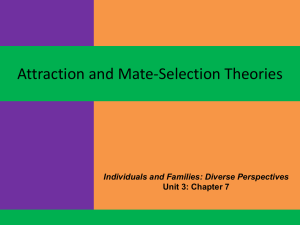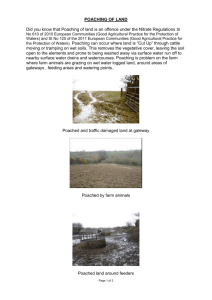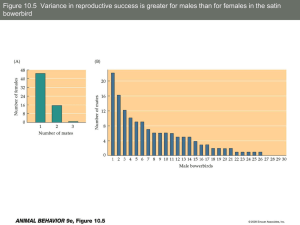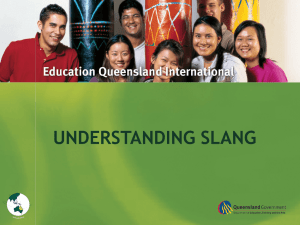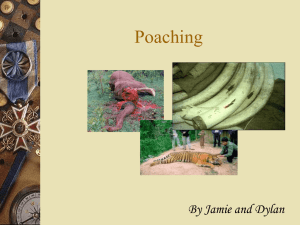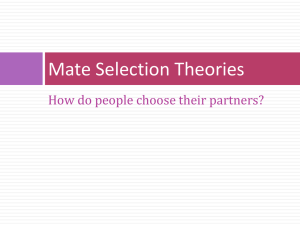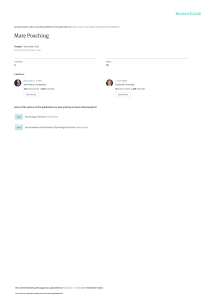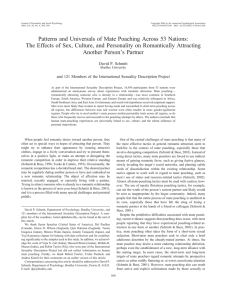mate poaching panel project, summary, outline, test
advertisement
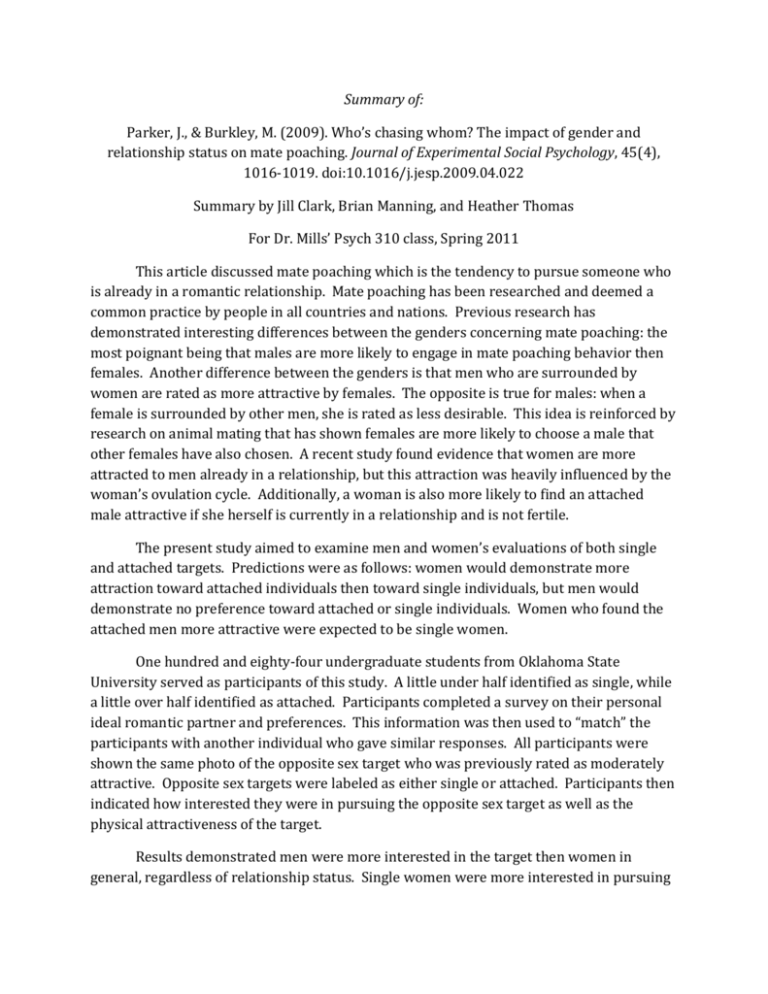
Summary of: Parker, J., & Burkley, M. (2009). Who’s chasing whom? The impact of gender and relationship status on mate poaching. Journal of Experimental Social Psychology, 45(4), 1016-1019. doi:10.1016/j.jesp.2009.04.022 Summary by Jill Clark, Brian Manning, and Heather Thomas For Dr. Mills’ Psych 310 class, Spring 2011 This article discussed mate poaching which is the tendency to pursue someone who is already in a romantic relationship. Mate poaching has been researched and deemed a common practice by people in all countries and nations. Previous research has demonstrated interesting differences between the genders concerning mate poaching: the most poignant being that males are more likely to engage in mate poaching behavior then females. Another difference between the genders is that men who are surrounded by women are rated as more attractive by females. The opposite is true for males: when a female is surrounded by other men, she is rated as less desirable. This idea is reinforced by research on animal mating that has shown females are more likely to choose a male that other females have also chosen. A recent study found evidence that women are more attracted to men already in a relationship, but this attraction was heavily influenced by the woman’s ovulation cycle. Additionally, a woman is also more likely to find an attached male attractive if she herself is currently in a relationship and is not fertile. The present study aimed to examine men and women’s evaluations of both single and attached targets. Predictions were as follows: women would demonstrate more attraction toward attached individuals then toward single individuals, but men would demonstrate no preference toward attached or single individuals. Women who found the attached men more attractive were expected to be single women. One hundred and eighty-four undergraduate students from Oklahoma State University served as participants of this study. A little under half identified as single, while a little over half identified as attached. Participants completed a survey on their personal ideal romantic partner and preferences. This information was then used to “match” the participants with another individual who gave similar responses. All participants were shown the same photo of the opposite sex target who was previously rated as moderately attractive. Opposite sex targets were labeled as either single or attached. Participants then indicated how interested they were in pursuing the opposite sex target as well as the physical attractiveness of the target. Results demonstrated men were more interested in the target then women in general, regardless of relationship status. Single women were more interested in pursuing an attached male compared to a single male. This means single women are more likely to engage in mate poaching behavior when the opposite sex target was in a relationship. These results demonstrate men are more likely to engage in mate poaching behavior regardless of the target’s relationship status whereas women seem to be more interested in pursuing a mate that is less available to them. This finding goes against the responses of a recent poll where women reported poaching behavior did not think the attached relationship status of the target played a role in their mate poaching behavior. This finding may be due to the fact that attached men, because in a relationship, demonstrate an availability of resources and ability to commit. These are key factors women use to choose a mate. Men who are attached have already demonstrated an availability of resources and ability to commit, and therefore are seen as acceptable mates. Article Outline 1. Gender Differences in Mate poaching a. Universal act b. Previously researched gender differences i. Men engage in mate poaching more, women less c. Animal mate poaching tendencies 2. Methods of Present Study a. 184 participants b. 2 X 2 X 2 factorial design c. Surveyed personal preferences d. showed photographs of opposite-sex target i. opposite sex target was labeled “single” or “attached” e. rate how interested they were in pursuing target and target’s attractiveness 3. Results/Discussion a. In general men more interested in target then women b. Single women more interested in poaching attached target c. Attached women less interested in pursuing attached target compared to single target Informative/Interesting: 1. Those who mate poach are more likely to score low in agreeableness and conscientiousness than those who did not on The Big Five Inventory 2. Women are more attracted to attached men but this effect is heavily influenced by the female’s ovulation cycle; women are more attracted to taken men, but only when in a relationship themselves and are not fertile 3. Men find women attractive regardless if attached or single Weaknesses: 1. For target photo, participants saw only one photograph of opposite sex; should have multiple photos of male and female targets 2. Photographs were of “moderately attractive” individuals, but asked to rate on a scale of 3 (very unattractive) to 3 (very attractive) 3. Participants had no communication with the target, simply indicated interest of future interactions Test Questions 1. Results demonstrated single women were more interested in poaching an attached target. Which theory does this emulate? a. Perfect Catch Hypothesis b. Darwin’s Theory of Natural Selection c. Sexy Son Hypothesis 2. True/False: Men rate women as less desirable when they are surrounded by other men 3. True/False: Are women more likely than men to prefer an already taken individual 4. Women are more attracted to attached men when their fertility is: a. Low b. High c. Fertility has no effect 5. The reasons for women preferring an attached male mate are: a. He has established a willingness to commit b. He has demonstrated availability of resources c. He is attractive to other females d. All of the above 6. True/False: Mate poaching is a specific activity of US and Europe inhabitants Answers: 1. C 2. T 3. T 4. A 5. D 6. F
